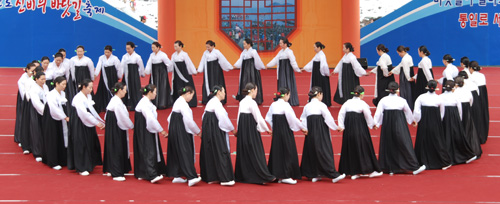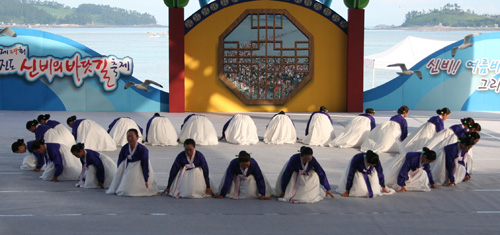강강수월래
Whenever Chuseok (Korean Thanksgiving day) comes on the 15th day on the eighth month of the lunar calendar, most Koreans head for their hometown to honor ancestors with newly harvested grains and fruits. Koreans serve dinner and drinks to each other and enjoy the feast as well as celebrating with songs and dance and playing various folk games. The most popular folk dance of Chuseok is Ganggangsullae, which is a Korean circle dance performed mainly under the bright moon. It has been performed in many kinds of festival until now. Let us feel the attraction of Ganggangsullae with a Tribune Reporter.

The Origin of Ganggangsullae
Ganggangsullae, designated as an Important Intangible Cultural Property No. 8 in 1966, is an emotional and rhythmic folk play that combines songs with dances and is performed by women. It has existed in the southwestern coastal region of Korea, including Haenam and Jindo counties where villagers have long performed under the moonlight around . There are different views about the origins of . One is it came from a strategic trick that Admiral Lee Sun-sin contrived in order to repel Japanese soldiers in their invasion of Korea in 1592. He suggested that women dress like men and spin around Mt. Okmae under the full moon to make an image that will frighten the enemy. It helped Admiral Lee win the battle. Residents of the village have commemorated the victory during since then. The other is that it originated from the tradition prevalent in that region in the prehistoric age when people were singing and dancing during the brightest moonlight of the year. As the region is very shallow, waves are running high and the flow of water is fast when moon is full. It is hard to catch fish. Therefore, residents usually spend time in a village. Besides, during the harvest, a full moon means a good crop and prosperity.
Last year on the 16th day of the eighth month according to the lunar calendar, this reporter visited Jindo, which is a representative region where has been handed down from generation to generation to cover . It was performed at the Jindo Local Culture Center as part of the revival of peculiar traditional folklore. Although it was still summer, the cool wind was blowing. When this reporter arrived at the hall, there was an unexpectedly big audience. The curtain rose. When the full moon rose on the stage, women performers gathered at the center of the stage in a circle and bowed. They stepped forward and started very slowly according to the melody of (the slowest rhythm). This reporter composed herself and waited with eager anticipation for In general, consists of three elements of dance, song and folk games. Before dancing , people hold hands and make a circle while singing a song under the full moon. The singer who has a beautiful and mellow voice leads the singing and the rest refrain “”. The dance usually changes its speed according to the music rhythm; it starts from slow , and gradually its tempo gets faster and proceeds toward moderate and very fast in order.

Ganggangsullae on the stage was getting faster and performers’ movements became more dynamic. They performed actions following the continuously changing melody of Jungmeori, Jungjungmeori and Jajeunmori. As the dance became faster, people divided them into teams and made circles respectively again. The words of songs were omitted or reduced to the fast refrain, Ganggangsullae. Owing to a feeling of dynamic rhythm and a beautiful and mellow voice, this reporter was excited and was dancing a hula spontaneously. When Ganggangsullae reached the culmination of its performance, older people at the hall started to sing with much mirth. They joined in and sang “Ganggangsullae” together. Their song was reverberating through the hall. They looked happy with singing together.
Watching the Ganggangsullae performance, this reporter heard an old lady’s saying, “I remember that I did Ganggangsullae when I was a child. At that time I waited for the day that Ganggangsullae was held, counting down the days. At the bright moon night, most villagers including me got together and did Ganggangsullae. We each other’s hand and started turn round and round with singing “Ganggangsullae” with one voice and played all night. I miss it.” This reporter thought this power was the attraction of Ganggangsullae to make all people get together and strengthen their ties in a community.
When the performance reached its climax after singing and dancing, they enjoyed playing various games such as Giwabalgi (thread roof tiles) and Daemoonnori (open doors). This reporter was surprised that Ganggangsullae includes a variety of folk games because I thought it is only a circle dance. These folk games made me feel a dynamic vitality and harmonious unity of their performance.

The performance lasted for about 20 minutes because Ganggangsullae has changed into the type of stage performance restricted by time. Originally, people continued with their performance until daybreak and ends with a participatory circle dance with everyone. If the performance were an outdoor one, I could enjoy Ganggangsullae together with all the people at the place. It is a great pity that I could not participate in dancing and playing folk games of Ganggangsullae in person. However, the performance was very exciting and very cheerful and free. I had a deeper understanding of Ganggangsullae. It seems to be a valuable folk custom and art as one of Korean folk arts.
That is Ganggangsullae!
On June 22, 2002, this reporter experienced the attraction of Ganggangsullae. At the square in front of the Jeonam Provincial Office building, I was holding hands with strangers, including foreigners, and making a circle and dancing to congratulate the victory of South Korea against Spain at the quarterfinal of the FIFA World Cup. We shared joys and happiness from the victory by dancing and singing together. Is the circle dance Ganggangsullae? Yes of course, even if our songs and movements were not the same as the original Ganggangsullae.
Ganggangsullae is easy and open to everyone who wants to participate and enjoy it. You can participate in and enjoy Ganggangsullae only if you hold hands with a person next to you. Ganggangsullae, a lively dancing party, has the power to make diverse individuals one. While being absorbed in the circle dance, they could be inspired and become closer to each other by enjoying its energetic rhythm as if I did in the square in 2002. It is no secret that countries have been striving to increase their international competitiveness by improving their respective images through the presentation of their arts and cultures. Ganggangsullae, Korea’s distinctive cultural heritage deserves to be introduced to foreigners.

[282 The Road to Namdo]
Enjoying Ganggangsullae

